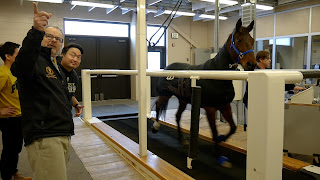Biomedical engineers and veterinarians have collaborated to produce the system that can monitor a horse’s cardiac, respiratory and muscular systems using Bluetooth technology. The e-textile garment can be used for long-term management of chronic health conditions in large animals, with the goal to have a version for human use.
Another advantage of the e-textile is that veterinarians and their support staff won’t have to shave the horse’s hair or use adhesives to place electrodes on the horse’s skin, which should make it more comfortable for the horse.
Findings of how the e-textile works is featured in a study published in the journal Advanced Materials.
Chi Hwan Lee, the Leslie A. Geddes associate professor of biomedical engineering in Purdue’s Weldon School of Biomedical Engineering, said the Purdue team developed a dual regime spray and technique to directly embed a pre-programmed pattern of functional nanomaterials into the fabric to add the e-textile capabilities.
“These specially designed e-textiles can comfortably fit to the body of humans or large animals under ambulatory conditions to collect bio-signals from the skin such as heart activity from the chest, muscle activity from the limbs, respiration rate from the abdomen or other vital signs in an extremely slight manner,” Lee said. “Our technology will significantly extend the utility of e-textiles into many applications in clinical settings.”
The team’s next steps involve developing continuous 24-hour monitoring of horses with chronic disease or those receiving care in a veterinary ICU.
“We believe that our technology will be helpful in diagnosis or management of chronic diseases,” Lee said, especially as demand increases for remote health monitoring.
“Remote health monitoring under ambulatory conditions would be useful for farm and household animals, as it could potentially minimize clinic visits, especially in rural areas. It would also increase the efficiency in managing a large number of farm/household animals at once from a distance, even overnight,” he added.
A real-life example would be the ability to monitor severe equine asthma, which affects 14% of adult horses.
“Continuous monitoring would allow early detection of disease flair-up before it gets serious, offering an opportunity to nip it in the bud,” said Laurent Couëtil, a professor of large animal internal medicine in Purdue’s College of Veterinary Medicine and collaborator in the study. “Remote monitoring opens the possibility of sending vital information to the veterinarian to help make timely and informed treatment decisions.”
For more details, see:
A Programmable Dual-Regime Spray for Large-Scale and Custom-Designed Electronic Textiles
Taehoo Chang, Semih Akin, Min Ku Kim, Laura Murray, Bongjoong Kim, Seungse Cho, Sena Huh, Sengul Teke, Laurent Couetil, Martin Byung-Guk Jun, Chi Hwan Lee
Advanced materials (2022) Vol 34, 2108021


No comments:
Post a Comment